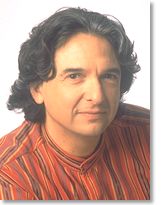|
 Director Gregory Nava
Director Gregory Nava
Film Notes:
EL NORTE
EL NORTE (USA, 1983, 141 mins., color, in Mayan, Spanish and English
with English subtitles) Director: Gregory Nava; screenplay: Gregory
Nava and Anna Thomas; producer: Anna Thomas for PBS American Playhouse;
music: Lida Saskova; sound editor: Michael Moore; set designer:
David Wasco; cinematographer: Mike Glennon with additional photography
by Gregory Nava. Music by Los Folkloristas. CAST: Rosa (Zaide Silvia
Gutierrez); Enrique (Daivd Villalpando); father (Ernesto Gomez Cruz);
mother (Alicia del Lago); Trinidad Silva (Monty); Heraclio Zepeda;
Stella Quan; Lupe Ontiveros.
A young Guatemalan brother and sister, Enrique and Rosa, fearing
for their lives, flee their native land following the brutal murder
of their father by government soldiers. The film follows their harrowing
journey through Mexico and across the border to the promised land
of "El Norte." Sustained during the hazardous trip by visions of
the American "good life" gleaned from mail-order catalogs, they
finally arrive in Los Angeles only to confront a far harsher reality.
This epic film is told in three parts: the first and third rich
in color and imagery, the second filled with squalor as the protagonists
attempt to find a "coyote" who will lead them from Tijuana to Los
Angeles, California and what they think will be freedom and wealth.
There are two major strands in the first part of the film. We see
the political realities of life in contemporary Guatemala, a country
which, in 1983, brutally killed some 5,000 of its citizens, mostly
Indians like Enrique's father with connections to the country's
poorly organized guerilla forces. The indigenous Mayan culture has
been systematically beaten back by an oligarchy that treats Indians
as no better than slaves. Many of those threatened have escaped
to "the North;" most enter the US illegally. The other strand involves
the Mayan culture, its traditional rites and rituals existing and
persisting in defiance of the fascist regime. Here director Gregory
Nava uses dream images, many of them derived from the magical realism
of contemporary Latin American literature, such as Gabriel Garcia
Marquez' s One Hundred Years of Solitude. In the end, El
Norte makes its statement of social criticism on a humanistic
level rather than a political one, employing myth and visual poetry
to articulate the allegorical qualities of this journey into exile.
The film has been praised for its stunning visual and musical power,
for its poetic and fantastical imagery to portray the subject of
"undocumented workers." It tells its story through the (albeit mythical)
protagonists' perspective, and is one of the rare American films
to grant Latin American Indians full humanity. The film was co-written
by director Gregory Nava and his producer-wife Anna Thomas. Described
by Variety as the "first American independent epic," this
film was made entirely outside the studio system by two gifted filmmakers
(their credits include The Confessions of Amans [1976], which
won a Gold Hugo at the Chicago Film Festival, The Haunting of
M. [1979], and A Time of Destiny [1988]). More recently,
Nava directed My Family/Mi Familia (1995) and Selena (1997).
Discussion questions for journal entries and class:
1. Discuss the use of different styles in the film--magical realism
and social realism--to depict the harrowing journey and experiences
of Maya-QuichŽ exiles in the United States. In what ways does the
filmmaker integrate his social criticism and political vision with
dream images associated with Latin American literature? Cite specific
examples.
2. Analyze the structure of the film: how are images in the second
and third parts of El Norte contrasted with those in the
first segment? Are there also certain scenes and images at the end
of the film that echo or repeat those in Part I, "Arturo Xuncax."
In what ways does the structure suggest El Norte's ironic
and tragic vision of "the promised land"?
3. Discuss Enrique's and Rosa's experiences of being illegal immigrant
workers in southern California and their different responses to
their new environment, discrimination, and the challenges of building
a new life in an alien place. What does Rosa represent in the film,
and how does her illness from the rat bites during their escape
through the sewer pipes pose a tragic dilemma for her brother caught
between two cultures and value systems at the end of the film? (incorporate
some discussion of Vincent Parrillo's work on the role of culture
and social structure in affecting ethnic immigrant minorities' perceptions
and response patterns here).
4. Using the readings on Mayan myth, analyze the mythic allusions
and narrative structure of El Norte. Why do you think the
director chose to include these references to ancient Mayan creation
myths in a modern film about immigration and undocumented workers
from Guatemala?
5. Comment on Rosa's final words, "We're not free. In our country
we have no home. We can make no home in Mexico. In the North we
are not accepted. When will we find a home?" in light of the film's
trajectory as a whole, their journey north in search for a better
life, and in relation to Parrillo's theories of minority integration
and Grinberg's discussion of the particular plight of the exile.
Additional Resources:
Check out an interview
with director Gregory Nava in Cineaste on the making of El Norte
and Mi Familia.
For more resources on Latinos and Chicanos in visual media, consult
the Berkeley
Media Resource Center page.
|
![]()